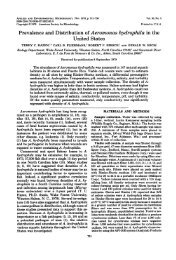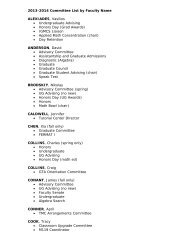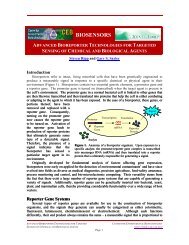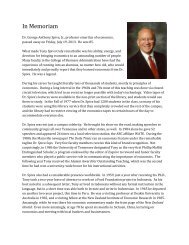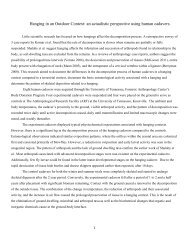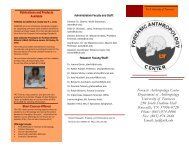Species of Xerula from sub-Saharan Africa
Species of Xerula from sub-Saharan Africa
Species of Xerula from sub-Saharan Africa
You also want an ePaper? Increase the reach of your titles
YUMPU automatically turns print PDFs into web optimized ePapers that Google loves.
Fungal Diversity<br />
X. furfuracea they are <strong>of</strong>ten rotund fusiformcapitulate);<br />
2) mid-stipe caulocystidia in X.<br />
furfuracea and X. chiangmaiae occur in<br />
scattered fascicles, while those <strong>of</strong> X. kenyae are<br />
so extensive as to give the stipe a scabrouslacerate<br />
appearance; and 3) basidiomatal color<br />
(especially pileus) in X. kenyae is significantly<br />
darker brown (sepia brown) than that in X.<br />
furfuracea ("clay color," "sayal brown") but<br />
comparable to that in X. chiangmaiae ("bister"<br />
to "Saccardo's umber"). The pileus in X.<br />
chiangmaiae is sometimes radially streaked<br />
just as in X. kenyae.<br />
A third specimen [MALAWI, Machemba<br />
Hill, 9.II.1980, coll B Morris, BM 98 (K[M]<br />
144259)] conforms to X. kenyae in<br />
macromorphology (i.e. dark brown pileus,<br />
support microscopic examination. It would<br />
represent an expanded geographic distribution<br />
in <strong>sub</strong>-<strong>Saharan</strong> east <strong>Africa</strong>.<br />
Specimens examined: ETHIOPIA, Kaffa Prov.<br />
(Katta <strong>of</strong> label), Mount Karkarha (Karkarta <strong>of</strong> label)<br />
(Mount Bamboo), c. 10 mi SSE <strong>of</strong> Mezan Tefari (Mezan<br />
Tetari <strong>of</strong> label), 35°25′ E, 6° 58′ N, 18.II.1976, coll J<br />
Ash, Ash 3448 [K(M) 144260]. KENYA, Rift Valley<br />
Prov., vic. Timboroa, Cengalo, IV.1970, coll. J.K.<br />
Dedan, I.A.S. Gibson no. 2172 [K(M) 124280].<br />
5. <strong>Xerula</strong> mammicystis R.H. Petersen, sp. nov.<br />
(Figs 24-29)<br />
MycoBank: 511155<br />
Basidiomata collybioidea, gracilis, radicata. Pileo<br />
25-30 mm lato, plano-convexo, vix umbonato, sicco,<br />
olivaceo-brunneo asolivaceo-nigro; margine crenato.<br />
Lamellis albis, adnatis, non-marginatis, <strong>sub</strong>ventricosis.<br />
Stipite 85-100 × 1-1.5 mm, apice albo, deorsum brunneo<br />
ad atrobrunneo, minuto piloso; pseudorhiza nonexpansis,<br />
longis.<br />
Pileocystidiis 24-82 × 14-30 µm, pedicellatis,<br />
<strong>sub</strong>sphaeropedunculatis, sine fibulis, pallide olivaceis.<br />
Pleurocystidiis 110-150 × 25-34 µm, fusiformis cum<br />
apex elongates, fibulatis, hyalinis. Basidiis 61-83 × 15-<br />
20 µm, clavatis, tetra-sporibus, fibulatis. Basidiosporis<br />
17.5-21 × 11-13 µm (E m = 1.58; L m = 19.2 µm),<br />
ellipsoidiis ad <strong>sub</strong>amygdaliformis. Cheilocystidiis 39-<br />
136 × 17-40 µm, pediucellatis, clavatis ad fusiformis,<br />
mammilatis, fibulatis, hyalinis. Caulocystidiis 85-178 ×<br />
15-19 µm, cylindricis ad clavatis, crassi-tunicatis.<br />
Holotype: NIGERIA, Cross River State,<br />
Obudu Ranch, 29.IV.1990, coll RA Nicholson<br />
(as O. radicata var. africana), Nicholson 400<br />
[K(M) 16682].<br />
Basidiomata (Fig. 24) gracile, collybioid,<br />
rooting. Pileus 25-30 mm broad, plano-convex<br />
with shallow, broad umbo, smooth to suedelike<br />
(dry, with no evidence <strong>of</strong> viscidity) over<br />
umbo, crenate over margin, matt (minutely<br />
farinose at 35×), deep olive-brown over disc,<br />
deep olive over limb, olive-black over margin;<br />
margin downturned. Lamellae white when<br />
fresh, now “light ochraceous buff,” adnate with<br />
decurrent tooth, not marginate, <strong>sub</strong>ventricose,<br />
up to 7 mm deep, in three ranks, minutely<br />
frosted with hyaline pleurocystidia (30×). Stipe<br />
85-100 mm to ground line, 1-1.5 mm broad<br />
through length, flaired slightly apically, white<br />
to <strong>of</strong>f-white apically, soon brown to dark<br />
brown, hardly lined, apically minutely roughened<br />
(30×) with white caulocystidia, downward<br />
minutely roughened (30×) with brown<br />
caulocystidia; pseudorhiza without expansion,<br />
rooting at least 40 mm, brown with sparse <strong>of</strong>fwhite<br />
tomentum.<br />
Habitat: unknown; 1600 m elev.<br />
Pileipellis near disc constructed <strong>of</strong> a single<br />
element. Pileocystidia (Fig. 25) 24-74 × 14-30<br />
µm, pedicellate or hardly so, sphaeropedunculate<br />
to strangulate, thinwalled, without clamp<br />
connection; contents homogeneous, weakly<br />
olive. Pileocystidia <strong>from</strong> pileus margin similar,<br />
33-62 × 14-23 µm, short- to long-pedicellate,<br />
sphaeropedunculate to strangulate, thin-walled,<br />
without clamp connection; contents homogeneous,<br />
weakly olive. Subpellis hyphae<br />
clamped. Pleurocystidia (Fig. 26) 110-150 ×<br />
25-34 µm, pedicellate, fusiform with extended<br />
neck (but not expanded into a capitulum), thinwalled,<br />
clamped; contents homogeneous,<br />
hyaline, sometimes refringent at apex. Basidia<br />
(Fig. 27) 61-83 × 15-20 µm, clavate, <strong>from</strong> wide<br />
base, 4-spored, <strong>of</strong>ten sclerified, obscurely<br />
clamped; contents multiguttulate and refringent<br />
at maturity. Basidiospores (Fig. 27) 17.5-21 ×<br />
11-13 µm (E = 1.42-1.74; E m = 1.58; L m = 19.2<br />
µm), ellipsoid, <strong>sub</strong>-elongate-ovate to slightly<br />
amygdaliform, delicately dimpled, appearing<br />
thick-walled (but probably not so); contents<br />
opalescent when immature, obscurely guttulate<br />
at maturity but hardly refringent. Lamellar<br />
trama composed <strong>of</strong> two hyphal widths: 1) 13-<br />
25 µm broad, restricted at septa, thick-walled<br />
(wall up to 1.0 µm thick), hyaline, obscurely<br />
clamped; and 2) 3.5-5.5 µm diam, thin-walled,<br />
prominently clamped, hyaline. Lamellar<br />
margin sterile, a solid beard <strong>of</strong> cheilocystidia,<br />
extended significantly in KOH. Cheilocystidia<br />
135





